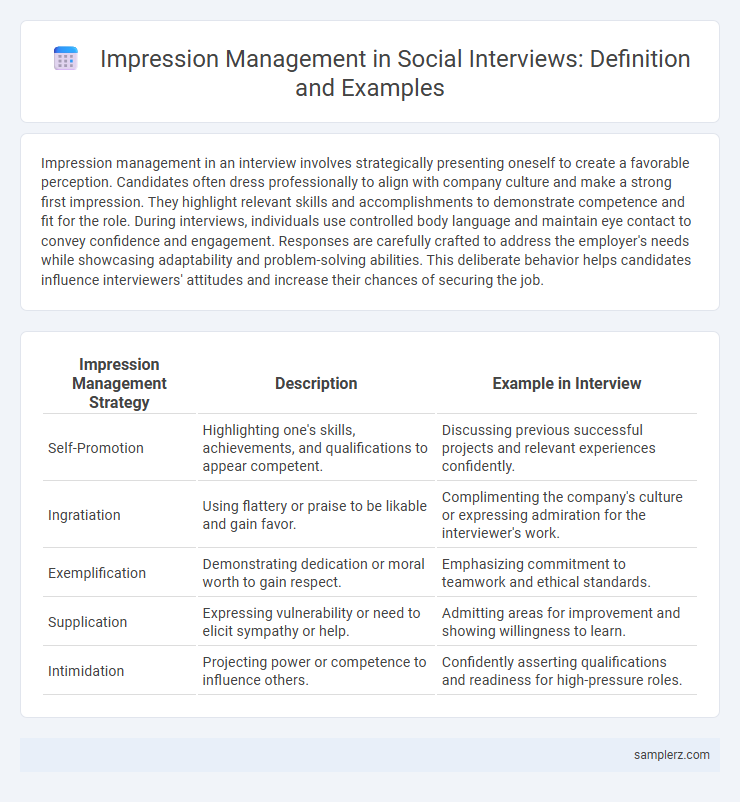Impression management in an interview involves strategically presenting oneself to create a favorable perception. Candidates often dress professionally to align with company culture and make a strong first impression. They highlight relevant skills and accomplishments to demonstrate competence and fit for the role. During interviews, individuals use controlled body language and maintain eye contact to convey confidence and engagement. Responses are carefully crafted to address the employer's needs while showcasing adaptability and problem-solving abilities. This deliberate behavior helps candidates influence interviewers' attitudes and increase their chances of securing the job.
Table of Comparison
| Impression Management Strategy | Description | Example in Interview |
|---|---|---|
| Self-Promotion | Highlighting one's skills, achievements, and qualifications to appear competent. | Discussing previous successful projects and relevant experiences confidently. |
| Ingratiation | Using flattery or praise to be likable and gain favor. | Complimenting the company's culture or expressing admiration for the interviewer's work. |
| Exemplification | Demonstrating dedication or moral worth to gain respect. | Emphasizing commitment to teamwork and ethical standards. |
| Supplication | Expressing vulnerability or need to elicit sympathy or help. | Admitting areas for improvement and showing willingness to learn. |
| Intimidation | Projecting power or competence to influence others. | Confidently asserting qualifications and readiness for high-pressure roles. |
First Impressions: Dress and Grooming in Interviews
First impressions in interviews are heavily influenced by dress and grooming, as candidates who wear professional attire and maintain neat grooming are perceived as more competent and confident. Studies show that 55% of interviewers make initial judgments based on appearance before the candidate speaks. Effective impression management through appropriate clothing and grooming enhances the likelihood of positive evaluations and job offers.
Mastering Body Language to Convey Confidence
Mastering body language during an interview showcases confidence by maintaining steady eye contact, offering a firm handshake, and sitting upright with open posture. Controlled gestures and deliberate movements reinforce a composed demeanor, signaling professionalism and self-assurance to interviewers. Nonverbal cues such as smiling appropriately and nodding affirm engagement and receptiveness, crucial for positive impression management.
Strategic Self-Presentation: Highlighting Strengths
In interviews, candidates often engage in strategic self-presentation by emphasizing their most relevant skills and achievements to align with the job requirements. Highlighting specific examples of successful projects or quantifiable results helps create a positive and competent impression. This deliberate portrayal influences interviewer perceptions, increasing the likelihood of a favorable outcome.
Tailoring Communication Style for the Interview Panel
Tailoring communication style for the interview panel involves analyzing the panel's background and adjusting language, tone, and body language to align with their expectations and organizational culture. Candidates might adopt a formal, concise approach for corporate panels or a more relaxed, narrative style for creative industries, enhancing relatability and engagement. This strategic impression management increases the likelihood of positive evaluations by demonstrating adaptability and social awareness.
Managing Verbal Responses to Showcase Competence
In interview settings, managing verbal responses effectively demonstrates competence by providing clear, concise, and relevant answers that align with the job requirements. Candidates strategically use positive language, avoid fillers, and highlight specific achievements to create a favorable impression. This controlled verbal communication signals confidence and expertise, influencing interviewers' perceptions of the candidate's suitability.
Using Positive Language to Influence Perceptions
Using positive language during an interview enhances impression management by shaping how candidates are perceived, emphasizing strengths and achievements rather than weaknesses or failures. Candidates who employ affirmative phrases and active voice convey confidence, competence, and enthusiasm, which positively influences interviewers' judgments. This strategic use of positive language contributes to creating a favorable and memorable impression that can significantly impact hiring decisions.
Adapting Nonverbal Cues for Professional Environments
Adapting nonverbal cues in interviews enhances impression management by conveying confidence and professionalism through controlled eye contact, purposeful gestures, and a composed posture. Candidates who adjust their facial expressions to reflect attentiveness and positivity are more likely to connect with interviewers and leave favorable impressions. Mastery of body language tailored to professional settings significantly influences recruiters' perceptions and increases the likelihood of successful outcomes.
Balancing Honesty with Self-Promotion
In interview settings, effective impression management involves candidly sharing achievements while strategically highlighting relevant skills to align with the employer's needs. Candidates balance honesty with self-promotion by framing experiences truthfully yet emphasizing contributions that showcase their value. This approach fosters trust and leaves a positive, credible impression on interviewers.
Responding to Behavioral Questions with STAR Technique
Effective impression management in interviews involves responding to behavioral questions using the STAR technique, which structures answers by outlining the Situation, Task, Action, and Result. This method demonstrates clear communication, problem-solving skills, and results-oriented behavior, positively influencing the interviewer's perception. Mastery of the STAR technique showcases professionalism and preparedness, crucial factors in social interactions during high-stakes evaluations.
Closing the Interview: Leaving a Lasting Positive Impression
Closing the interview with a firm handshake and genuine thank-you remark reinforces professionalism and confidence, enhancing impression management. Articulating enthusiasm for the role while summarizing key strengths leaves a memorable impact on the interviewer. Providing a brief follow-up message after the interview further solidifies a positive and lasting impression.

example of impression management in interview Infographic
 samplerz.com
samplerz.com